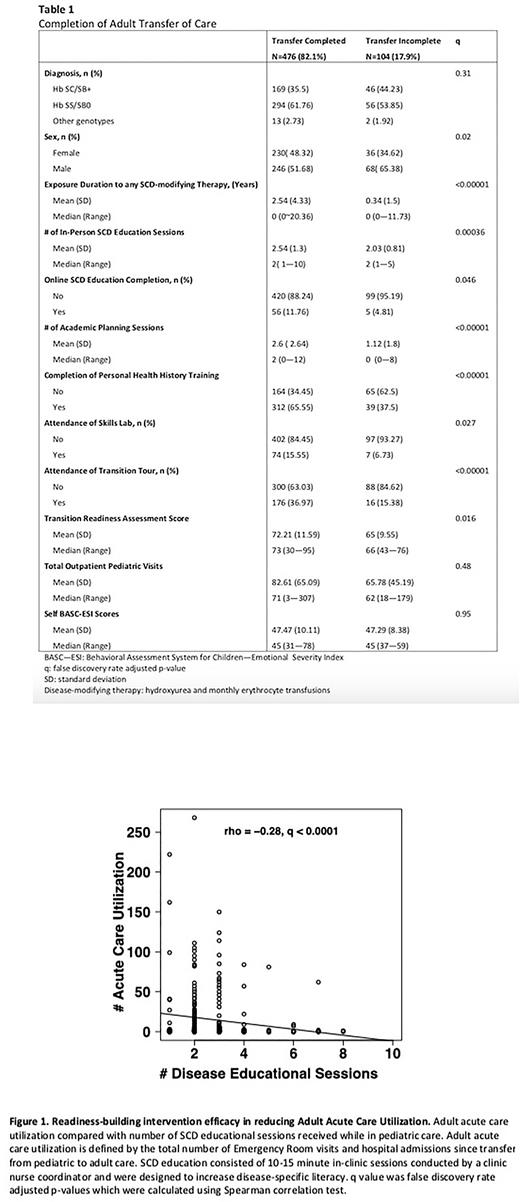Abstract

Background Progress in pediatric care has improved survival into adulthood for children with sickle cell disease (SCD); however, mortality and acute care utilization rise among emerging adults. With unmet needs to improve health outcomes in young adults, SCD effective transition programs that transfer care from pediatric to adult providers are needed. Since 2007, the St. Jude Children's Research Hospital (SJCRH) SCD Transition to Adult care Program has served patients between 12-25 years of age by providing transition readiness-building activities, including in-person and online SCD education, experiential learning, academic planning, and introduction to adult providers at age 17 years. We tested the efficacy of individual components of the SJCRH Transition Program in ensuring optimal post-pediatric transition outcomes.
Methods We retrospectively reviewed all patients with SCD treated at SJCRH who would have reached age 18 years between 2007 and 2020. Of the 722 patients, 142 (19.7%) died, relocated, or were lost to follow up before age 18 years and were excluded from the analysis. The association between pediatric transition intervention components and the following transition outcomes: 1) adult care transfer completion <6 months from completing pediatric care, 2) frequency of adult outpatient visits, 3) adult acute care utilization [emergency room (ER) and hospitalizations], and 4) quality of life (QoL) PedsQL™ SCDModule scores at ages 18 or 24 years was investigated using Wilcoxon rank sum, Fisher's exact, Spearman correlation (with spearman correlation coefficient ρ), or Kruskal Wallis tests. Analyses were adjusted for multiple comparisons to control for false discovery rate and q-value was calculated.
Results Of the 580 pediatric patients who received transition services to age 18, 476 (82.1%) completed adult transfer of care. There was no difference in completion of a first adult visit relative to SCD genotype or sex, but longer exposure duration to any SCD-modifying therapy was associated with higher rate of adult care transfer completion (Table 1). Patients who successfully transferred to adult care had significantly higher participation in all components of the transition program and higher transition readiness scores (Table 1). Frequency of pediatric outpatient visits was not associated with completion of a first adult visit. However, patients with a transfer gap <6 months had higher frequency of pediatric visits than those with ≥6 months gap (median 77 vs 27 visits/patient, respectively, q<0.00001).
Patients with HbSS/SB0-thalassemia attended more adult outpatient visits compared to those with HbSC/SB+thalassemia genotypes (median 62 vs 27 total visits/patient, q<0.0001). Longer exposure to any SCD-modifying therapy (ρ=0.44, q<0.00001), higher frequency of pediatric outpatient visits (ρ=0.61, q <0.00001), and adult provider introduction at 17 years (q=0.025) were associated with greater attendance to adult outpatient visits.
Longer exposure to SCD-modifying therapies (ρ=0.26, q<0.0001) was associated with higher adult acute care utilization, while no association was observed with SCD genotype and adult acute care utilization. Higher frequency of academic planning (ρ=-0.23, q=0.0002) and disease education sessions (ρ=-0.28, q<0.0001, Fig 1) were negatively correlated with adult acute care utilization.
QoL was lower among females than males (median q=0.002), but no differences were observed relative to SCD genotypes or duration of exposure to SCD therapies. The frequency of SCD education (ρ=0.19, q=0.008) and training on personal health history reporting (ρ=0.22, q=0.004) were positively correlated with QoL. More self-reported internalizing problems due to anxiety and depression (BASC-ESI scores) did not predict adult transfer completion but were associated with lower QoL in young adulthood (ρ=-0.32, q=0.008).
Conclusion The transition program at SJRCH was effective in placing 82% of patients in adult care. Demographic factors (sex, SCD genotype) were not always predictive of transition outcomes. However, our results suggest transition interventions designed to increase transition readiness may promote improved transition outcomes. Future analyses will focus on building multivariable models to determine the optimal combination of transition interventions to improve transition outcomes in SCD.
Disclosures
Heitzer:Global Blood Therapeutics: Consultancy. Porter:Forma Therapeutics: Consultancy. Hankins:GBT: Consultancy; NHLBI: Membership on an entity's Board of Directors or advisory committees, Research Funding; CDC: Research Funding; HRSA: Research Funding; ASH: Membership on an entity's Board of Directors or advisory committees; CVS Health: Consultancy; Forma Therapeutics: Consultancy.
Author notes
 This icon denotes a clinically relevant abstract
This icon denotes a clinically relevant abstract
Asterisk with author names denotes non-ASH members.


This feature is available to Subscribers Only
Sign In or Create an Account Close Modal